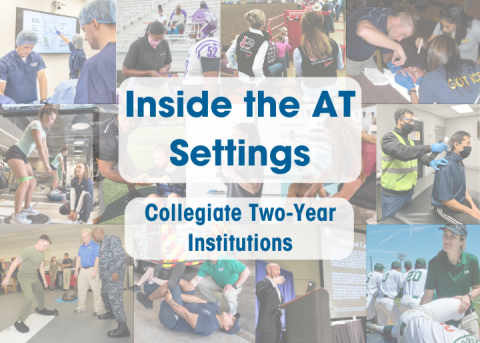
Introduced in the April NATA News, this NATA Now article series provides insight into the different athletic training settings as well as information athletic training students and interested ATs need to know. The series also provides tips from members on how to succeed in each setting.
Jared Brown, MS, LAT, ATC, assistant athletic trainer with Butler Community College in El Dorado, Kansas, has been in the collegiate two-year institutions setting for 10 years.
“My first job was at a two-year institution, Pratt Community College, so the process of moving to my current job at Butler Community College was a smooth process since they are both in the same conference,” he said. “I graduate from Butler Community College in 2008, and since graduating, I knew that I wanted to come back here and work.”
Below, Brown shares insight into his setting.
Typical Makeup of Your Population
Student athletes
Non-AT-Related Skills/Education/Certification Required or Helpful for Your Setting
I think one of the biggest things that helps in not only this setting but everywhere is just the ability to be a sounding board and listen to your athletes, not only about injuries. Sometimes we have athletes who we get close with and build a trust and rapport with, so they come and talk to you about what’s going on in their lives, good or bad.
Common Injuries Observed or Encountered in Your Setting
Obviously, it’s going to depend on the sport, but by and large, I would say the most common injuries we see are ankle/lower leg injuries. Obviously, we have had several more serious injuries, but ankle injuries are the ones we see quite often. Some of the others we have seen a lot of are knee injuries.
Traits of a Successful AT in Your Setting
- Thinking outside the box – we may not always have the recourses that Division I and II schools may have
- Managerial skills
- Budgeting
- Time management – sometime you may only have one to two ATs on staff, so you have to manage your time so you don’t burnout
- The ability to make do with what you have – we may not have the budget to be able to afford the best products or the latest modalities, so we have to make do with what we have, hence thinking outside the box
- Persistence – sometimes, at this level, we’re not going to get the things we need/want the first time we ask due to budget constraints, but being that “squeaky wheel” and/or coming up with a solution to be able to get those things done is a good trait to have anywhere, really, but at this level, it can sometimes be huge a positive
Misconceptions About Your Setting and/or Patient Population
Being a junior college, we hear a lot that it’s the last chance for these athletes. In actuality, they’re just as hardworking as any student athlete at the collegiate level.





